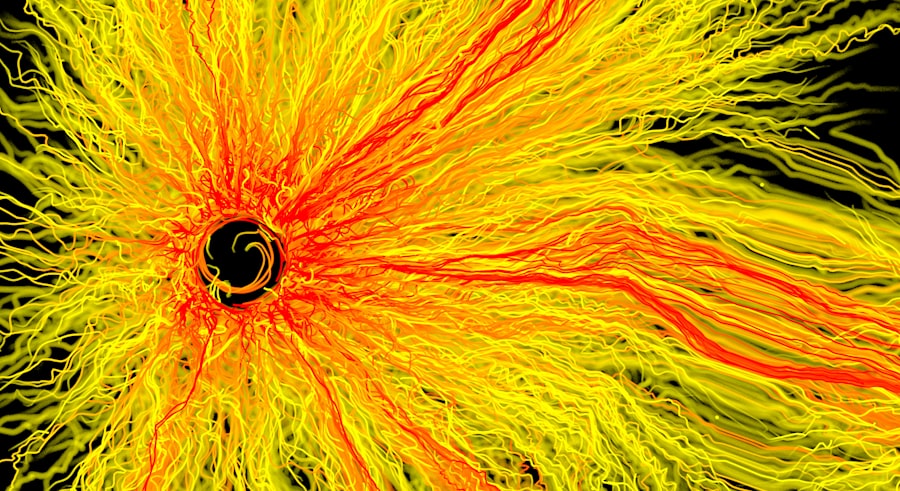Solar Cycle 25, which began in December 2019, represents the latest phase in the sun’s approximately 11-year cycle of solar activity. This cycle is characterized by fluctuations in the number of sunspots, solar flares, and other solar phenomena. The sun operates on a rhythm that influences not only its own behavior but also the environment of the entire solar system, including Earth.
As the cycle progresses, scientists observe changes in solar radiation and magnetic activity, which can have profound implications for both space weather and terrestrial conditions. The sun’s activity is driven by its magnetic field, which undergoes a complete reversal approximately every 11 years. During periods of heightened activity, known as solar maximum, the sun exhibits an increase in sunspots and solar flares.
Conversely, during solar minimum, these phenomena diminish significantly. Understanding Solar Cycle 25 is crucial for researchers and meteorologists alike, as it provides insights into the sun’s behavior and its potential effects on Earth and beyond.
Key Takeaways
- Solar Cycle 25 is the current cycle of solar activity, characterized by the sun’s magnetic field reversing and the number of sunspots increasing.
- Peak activity for Solar Cycle 25 is predicted to occur around 2025, with the potential for increased solar storms and radiation.
- Solar activity can impact Earth’s climate, with potential effects on weather patterns and the ozone layer.
- Solar storms have the potential to disrupt satellite communications and power grids on Earth.
- Increased solar radiation from Solar Cycle 25 requires preparation to protect astronauts and technology in space.
Predicting Peak Activity
As Solar Cycle 25 unfolds, scientists are keenly focused on predicting when peak activity will occur. Current forecasts suggest that the cycle will reach its maximum around 2025, although precise predictions remain challenging due to the complex nature of solar dynamics. Researchers utilize a variety of models and observational data to estimate the timing and intensity of solar maximum, which is expected to be more intense than the previous cycle, Solar Cycle 24.
The ability to predict peak activity is essential for preparing for potential impacts on technology and infrastructure. Enhanced solar activity can lead to increased occurrences of solar flares and coronal mass ejections (CMEs), which can disrupt satellite operations and power grids on Earth. By understanding when peak activity is likely to occur, scientists can better prepare for these events and mitigate their effects on modern society.
Impact on Earth’s Climate

The relationship between solar cycles and Earth’s climate is a subject of ongoing research and debate. While the sun’s output does influence climate patterns, the extent of its impact compared to other factors, such as greenhouse gas emissions, remains a complex issue.
During periods of high solar activity, increased ultraviolet radiation can lead to changes in atmospheric circulation patterns. These changes can affect weather systems and potentially influence phenomena such as El Niño and La Niña events. However, scientists emphasize that while solar cycles can have localized effects on climate, they are not the dominant force behind global warming trends observed over the past century.
Potential for Solar Storms
| Metrics | Value |
|---|---|
| Solar Flare Frequency | Varies |
| Geomagnetic Storm Risk | High |
| Solar Wind Speed | 300-500 km/s |
| Coronal Mass Ejection (CME) Probability | Medium |
One of the most significant concerns associated with Solar Cycle 25 is the potential for solar storms. These storms are caused by the release of energy from the sun in the form of solar flares and CMEs. When directed toward Earth, these events can create geomagnetic storms that disrupt communication systems, navigation technologies, and even power grids.
The intensity of these storms is expected to increase as Solar Cycle 25 approaches its peak. The potential for solar storms poses risks not only to technology but also to human health. Increased radiation exposure during intense solar events can affect astronauts in space and airline passengers flying at high altitudes.
As such, monitoring solar activity becomes crucial for ensuring safety during these periods of heightened risk. Scientists are working diligently to improve forecasting models to provide timely warnings about impending solar storms.
Effects on Satellite Communications
The impact of Solar Cycle 25 on satellite communications cannot be overstated. Satellites are particularly vulnerable to the effects of solar activity due to their position above the Earth’s atmosphere. Increased solar radiation can lead to disruptions in satellite signals, affecting everything from GPS navigation to telecommunications.
As Solar Cycle 25 progresses toward its peak, satellite operators must remain vigilant in monitoring solar conditions. In addition to signal disruptions, satellites may also experience physical damage from energetic particles released during solar storms. This damage can lead to malfunctions or even complete failure of satellite systems.
To mitigate these risks, engineers are developing more resilient satellite technologies and implementing strategies for real-time monitoring of space weather conditions. By doing so, they aim to ensure that critical communication networks remain operational even during periods of heightened solar activity.
Preparing for Increased Solar Radiation

As Solar Cycle 25 approaches its peak, preparations for increased solar radiation become paramount. Governments, industries, and researchers are collaborating to develop strategies that will help mitigate the effects of heightened solar activity on infrastructure and human health. This includes enhancing early warning systems for solar storms and improving the resilience of power grids and communication networks.
Public awareness campaigns are also essential in preparing communities for potential disruptions caused by solar storms. Educating individuals about the risks associated with increased solar radiation can empower them to take necessary precautions during periods of heightened activity. This proactive approach not only helps protect technology but also ensures that people are informed about how to respond in case of emergencies related to space weather.
Solar Cycle 25 and Space Exploration
Solar Cycle 25 holds significant implications for space exploration endeavors as well. As missions venture further into space, understanding solar activity becomes critical for ensuring the safety of astronauts and spacecraft. Increased solar radiation poses risks during long-duration missions beyond low Earth orbit, such as those planned for Mars exploration.
Space agencies are investing in research to better understand how solar cycles affect cosmic radiation levels in space. This knowledge will inform mission planning and help develop protective measures for astronauts during periods of heightened solar activity. By prioritizing safety in the face of unpredictable solar phenomena, agencies can enhance the success of future exploration missions.
Solar Cycle 25’s Influence on Technology
The influence of Solar Cycle 25 extends beyond immediate concerns about satellite communications and power grids; it also encompasses broader technological advancements. As society becomes increasingly reliant on technology, understanding how solar cycles affect electronic systems is vital for innovation and development. Engineers are exploring ways to design more robust technologies that can withstand the challenges posed by space weather.
Moreover, advancements in predictive modeling and monitoring systems are paving the way for improved responses to solar activity. By harnessing data from various sources, including satellites and ground-based observatories, researchers can create more accurate forecasts that inform decision-making across multiple sectors. This proactive approach not only enhances technological resilience but also fosters a culture of preparedness in an increasingly interconnected world.
Monitoring Solar Flares and Sunspots
Monitoring solar flares and sunspots is a critical aspect of understanding Solar Cycle 25. Scientists utilize a range of instruments, including ground-based observatories and space-based satellites, to track changes in solar activity. By observing sunspots—dark regions on the sun’s surface associated with magnetic activity—researchers can gain insights into the sun’s behavior and predict potential flares.
The study of solar flares is particularly important due to their potential impact on Earth’s environment. These explosive events release vast amounts of energy into space, which can interact with Earth’s magnetic field upon reaching it. Continuous monitoring allows scientists to issue timely warnings about impending flares that could disrupt technology or pose risks to astronauts in space.
Historical Patterns of Solar Cycle Activity
Understanding historical patterns of solar cycle activity provides valuable context for interpreting Solar Cycle 25. Historical records indicate that solar cycles have varied significantly in intensity over time, with some cycles exhibiting extreme levels of activity while others remain relatively quiet. By analyzing past cycles, researchers can identify trends that may inform predictions about current and future cycles.
For instance, historical data reveals that certain cycles have been associated with notable events such as geomagnetic storms that caused widespread disruptions on Earth. By studying these patterns, scientists can better understand the potential implications of Solar Cycle 25 and develop strategies for mitigating its effects on modern society.
The Role of Solar Cycle 25 in Renewable Energy
Solar Cycle 25 also plays a role in the renewable energy sector, particularly in relation to solar power generation. Increased solar activity can enhance the efficiency of photovoltaic systems by providing more sunlight during peak periods. As countries strive to transition toward renewable energy sources, understanding how solar cycles influence energy production becomes increasingly important.
Moreover, advancements in energy storage technologies are enabling greater integration of renewable sources into power grids. By harnessing data from solar cycles, energy providers can optimize their operations and ensure a stable supply of electricity even during fluctuations in solar output. This synergy between understanding solar cycles and advancing renewable energy technologies highlights the interconnectedness of natural phenomena and human innovation in addressing global energy challenges.
In conclusion, Solar Cycle 25 represents a significant phase in our understanding of solar dynamics and their implications for Earth and beyond. As scientists continue to monitor this cycle’s progression, they remain committed to enhancing preparedness for its potential impacts on technology, climate, space exploration, and renewable energy initiatives. The interplay between natural phenomena and human innovation underscores the importance of ongoing research in navigating the challenges posed by our ever-changing sun.
As we approach the peak activity of Solar Cycle 25, scientists and enthusiasts alike are keenly observing the sun’s behavior, anticipating a surge in solar phenomena such as sunspots and solar flares. This heightened solar activity can have significant implications for satellite communications, power grids, and even the auroras visible at higher latitudes. For a deeper dive into the intricacies of Solar Cycle 25 and its potential impacts, you can explore a related article on this topic by visiting com/’>Freaky Science.
This resource provides valuable insights into the science behind solar cycles and what we might expect as we near the cycle’s peak.
WATCH THIS 🌍 Earth’s Magnetic Field Is About To Flip: The Crisis You Need to Know
FAQs
What is solar cycle 25 peak activity?
Solar cycle 25 peak activity refers to the period of maximum solar activity during the 25th solar cycle, which is a roughly 11-year cycle of the Sun’s activity. This peak activity is characterized by an increase in the number of sunspots, solar flares, and other solar phenomena.
When is solar cycle 25 expected to reach its peak activity?
Solar cycle 25 is expected to reach its peak activity around the year 2025, according to predictions by solar physicists and researchers.
What are the potential effects of solar cycle 25 peak activity on Earth?
During the peak activity of solar cycle 25, there may be an increase in geomagnetic storms, which can affect satellite operations, power grids, and communication systems. Additionally, increased solar activity can lead to enhanced auroras at higher latitudes.
How is solar cycle 25 peak activity monitored and studied?
Solar cycle 25 peak activity is monitored and studied using a variety of instruments and techniques, including ground-based observatories, space-based telescopes, and satellite missions dedicated to studying the Sun. Scientists also use historical data and computer models to make predictions about solar cycle activity.
What are some of the key indicators of solar cycle 25 peak activity?
Key indicators of solar cycle 25 peak activity include the number of sunspots, solar flares, and coronal mass ejections (CMEs) observed on the Sun. These phenomena are closely monitored to track the progression of the solar cycle.
